Exploring Staff Turnover and Retention in Australian Hospitality
VerifiedAdded on 2023/06/11
|23
|5344
|242
Report
AI Summary
This report investigates staff turnover rates within the Australian hospitality industry, aiming to identify key factors driving turnover and effective retention strategies. The study employs a qualitative research method, drawing data from peer-reviewed journals and relevant literature. Findings highlight the importance of career advancement opportunities, employee involvement, fair promotions, competitive compensation, empowerment of women, comprehensive training programs, positive work environments, and flexible working hours in minimizing turnover. Conversely, the lack of growth prospects, low salaries, and limited employee development opportunities are identified as primary contributors to higher turnover rates. The research seeks to contribute to the existing body of knowledge, offering practical insights for improving workforce retention within the Australian hospitality sector, ultimately enhancing operational and financial efficiency in hotel chains across the nation. The report also acknowledges resource constraints, such as time limitations, that prevented a more extensive examination of hotels throughout Australia, which could have further generalized the study's findings.
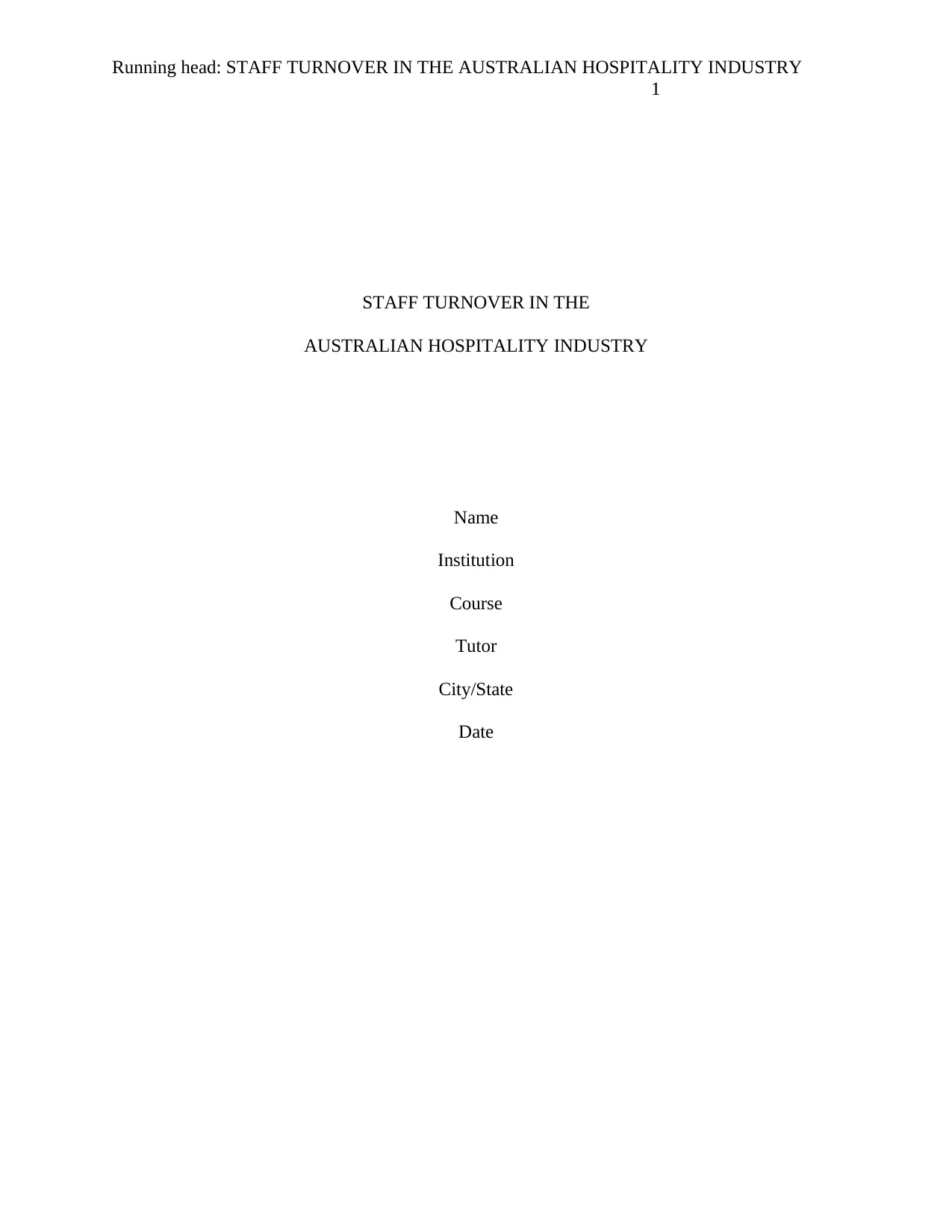
Running head: STAFF TURNOVER IN THE AUSTRALIAN HOSPITALITY INDUSTRY
1
STAFF TURNOVER IN THE
AUSTRALIAN HOSPITALITY INDUSTRY
Name
Institution
Course
Tutor
City/State
Date
1
STAFF TURNOVER IN THE
AUSTRALIAN HOSPITALITY INDUSTRY
Name
Institution
Course
Tutor
City/State
Date
Paraphrase This Document
Need a fresh take? Get an instant paraphrase of this document with our AI Paraphraser
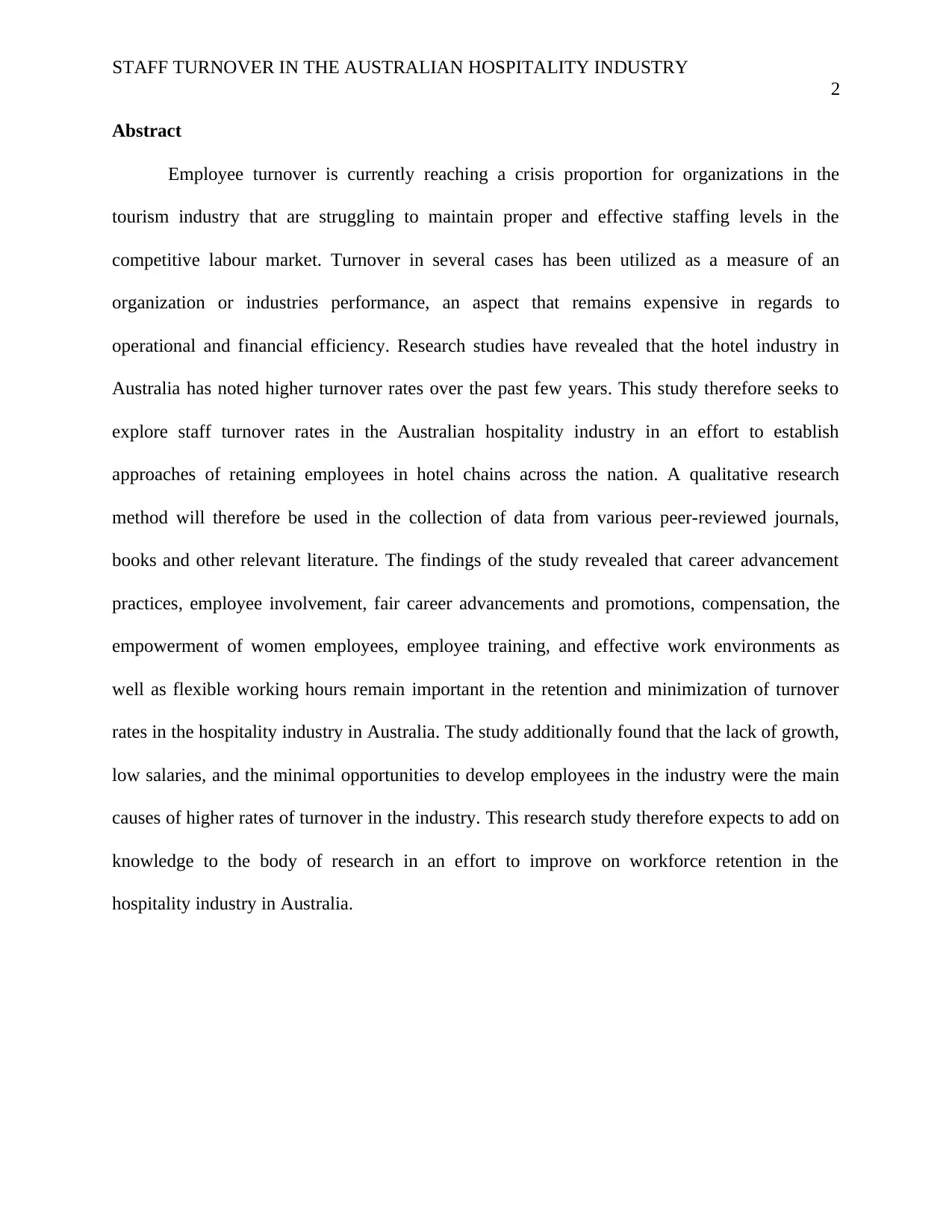
STAFF TURNOVER IN THE AUSTRALIAN HOSPITALITY INDUSTRY
2
Abstract
Employee turnover is currently reaching a crisis proportion for organizations in the
tourism industry that are struggling to maintain proper and effective staffing levels in the
competitive labour market. Turnover in several cases has been utilized as a measure of an
organization or industries performance, an aspect that remains expensive in regards to
operational and financial efficiency. Research studies have revealed that the hotel industry in
Australia has noted higher turnover rates over the past few years. This study therefore seeks to
explore staff turnover rates in the Australian hospitality industry in an effort to establish
approaches of retaining employees in hotel chains across the nation. A qualitative research
method will therefore be used in the collection of data from various peer-reviewed journals,
books and other relevant literature. The findings of the study revealed that career advancement
practices, employee involvement, fair career advancements and promotions, compensation, the
empowerment of women employees, employee training, and effective work environments as
well as flexible working hours remain important in the retention and minimization of turnover
rates in the hospitality industry in Australia. The study additionally found that the lack of growth,
low salaries, and the minimal opportunities to develop employees in the industry were the main
causes of higher rates of turnover in the industry. This research study therefore expects to add on
knowledge to the body of research in an effort to improve on workforce retention in the
hospitality industry in Australia.
2
Abstract
Employee turnover is currently reaching a crisis proportion for organizations in the
tourism industry that are struggling to maintain proper and effective staffing levels in the
competitive labour market. Turnover in several cases has been utilized as a measure of an
organization or industries performance, an aspect that remains expensive in regards to
operational and financial efficiency. Research studies have revealed that the hotel industry in
Australia has noted higher turnover rates over the past few years. This study therefore seeks to
explore staff turnover rates in the Australian hospitality industry in an effort to establish
approaches of retaining employees in hotel chains across the nation. A qualitative research
method will therefore be used in the collection of data from various peer-reviewed journals,
books and other relevant literature. The findings of the study revealed that career advancement
practices, employee involvement, fair career advancements and promotions, compensation, the
empowerment of women employees, employee training, and effective work environments as
well as flexible working hours remain important in the retention and minimization of turnover
rates in the hospitality industry in Australia. The study additionally found that the lack of growth,
low salaries, and the minimal opportunities to develop employees in the industry were the main
causes of higher rates of turnover in the industry. This research study therefore expects to add on
knowledge to the body of research in an effort to improve on workforce retention in the
hospitality industry in Australia.
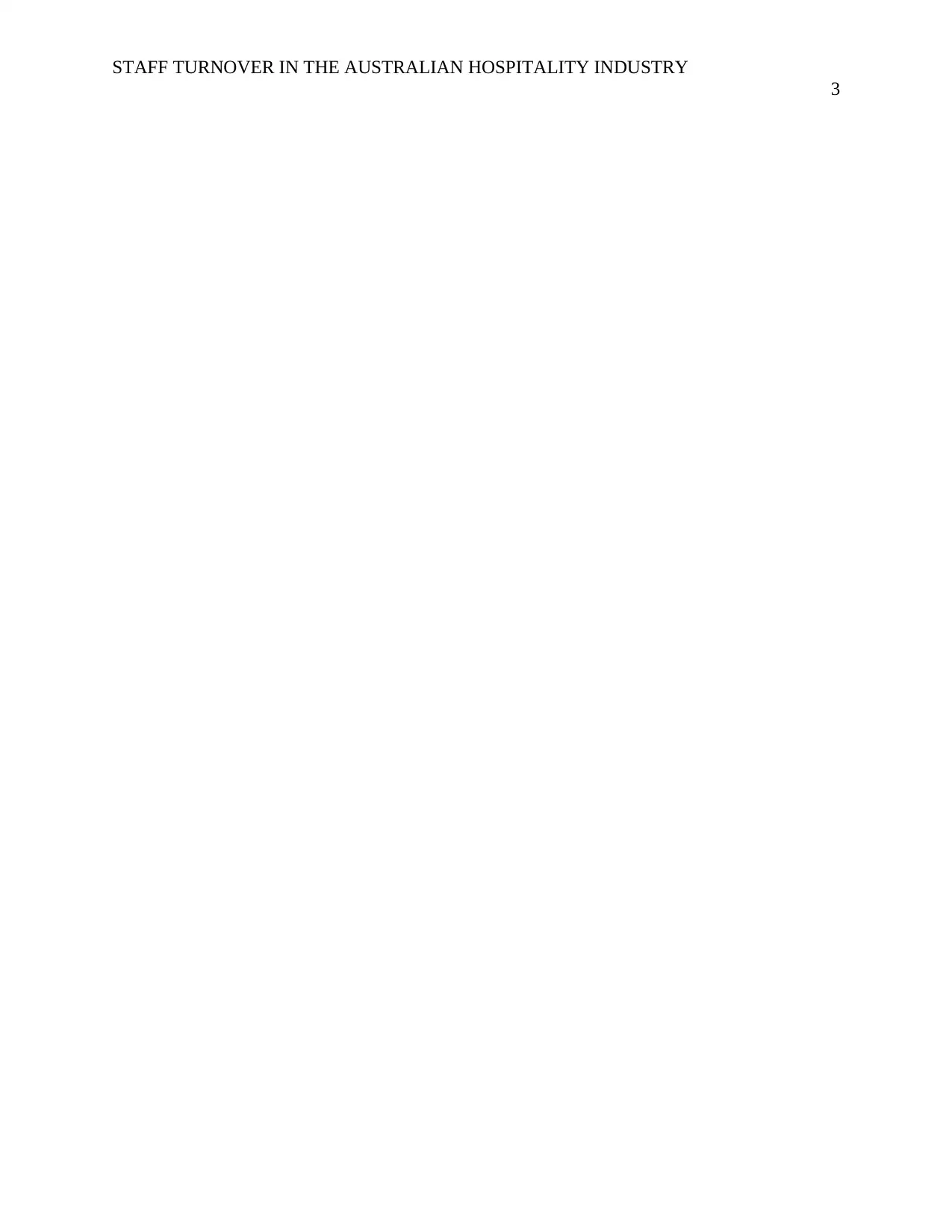
STAFF TURNOVER IN THE AUSTRALIAN HOSPITALITY INDUSTRY
3
3
⊘ This is a preview!⊘
Do you want full access?
Subscribe today to unlock all pages.

Trusted by 1+ million students worldwide
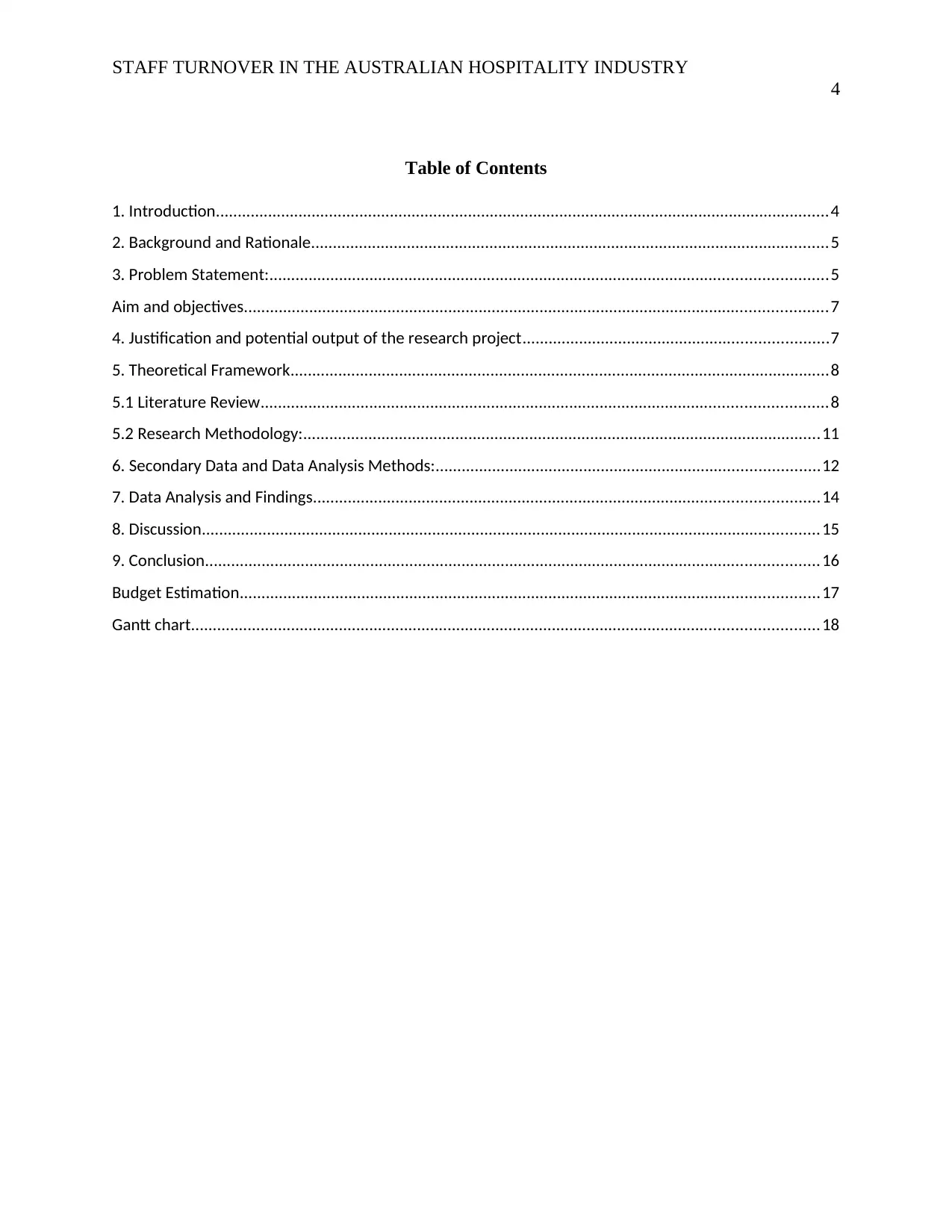
STAFF TURNOVER IN THE AUSTRALIAN HOSPITALITY INDUSTRY
4
Table of Contents
1. Introduction.............................................................................................................................................4
2. Background and Rationale.......................................................................................................................5
3. Problem Statement:................................................................................................................................5
Aim and objectives......................................................................................................................................7
4. Justification and potential output of the research project......................................................................7
5. Theoretical Framework............................................................................................................................8
5.1 Literature Review..................................................................................................................................8
5.2 Research Methodology:.......................................................................................................................11
6. Secondary Data and Data Analysis Methods:........................................................................................12
7. Data Analysis and Findings....................................................................................................................14
8. Discussion..............................................................................................................................................15
9. Conclusion.............................................................................................................................................16
Budget Estimation.....................................................................................................................................17
Gantt chart................................................................................................................................................18
4
Table of Contents
1. Introduction.............................................................................................................................................4
2. Background and Rationale.......................................................................................................................5
3. Problem Statement:................................................................................................................................5
Aim and objectives......................................................................................................................................7
4. Justification and potential output of the research project......................................................................7
5. Theoretical Framework............................................................................................................................8
5.1 Literature Review..................................................................................................................................8
5.2 Research Methodology:.......................................................................................................................11
6. Secondary Data and Data Analysis Methods:........................................................................................12
7. Data Analysis and Findings....................................................................................................................14
8. Discussion..............................................................................................................................................15
9. Conclusion.............................................................................................................................................16
Budget Estimation.....................................................................................................................................17
Gantt chart................................................................................................................................................18
Paraphrase This Document
Need a fresh take? Get an instant paraphrase of this document with our AI Paraphraser
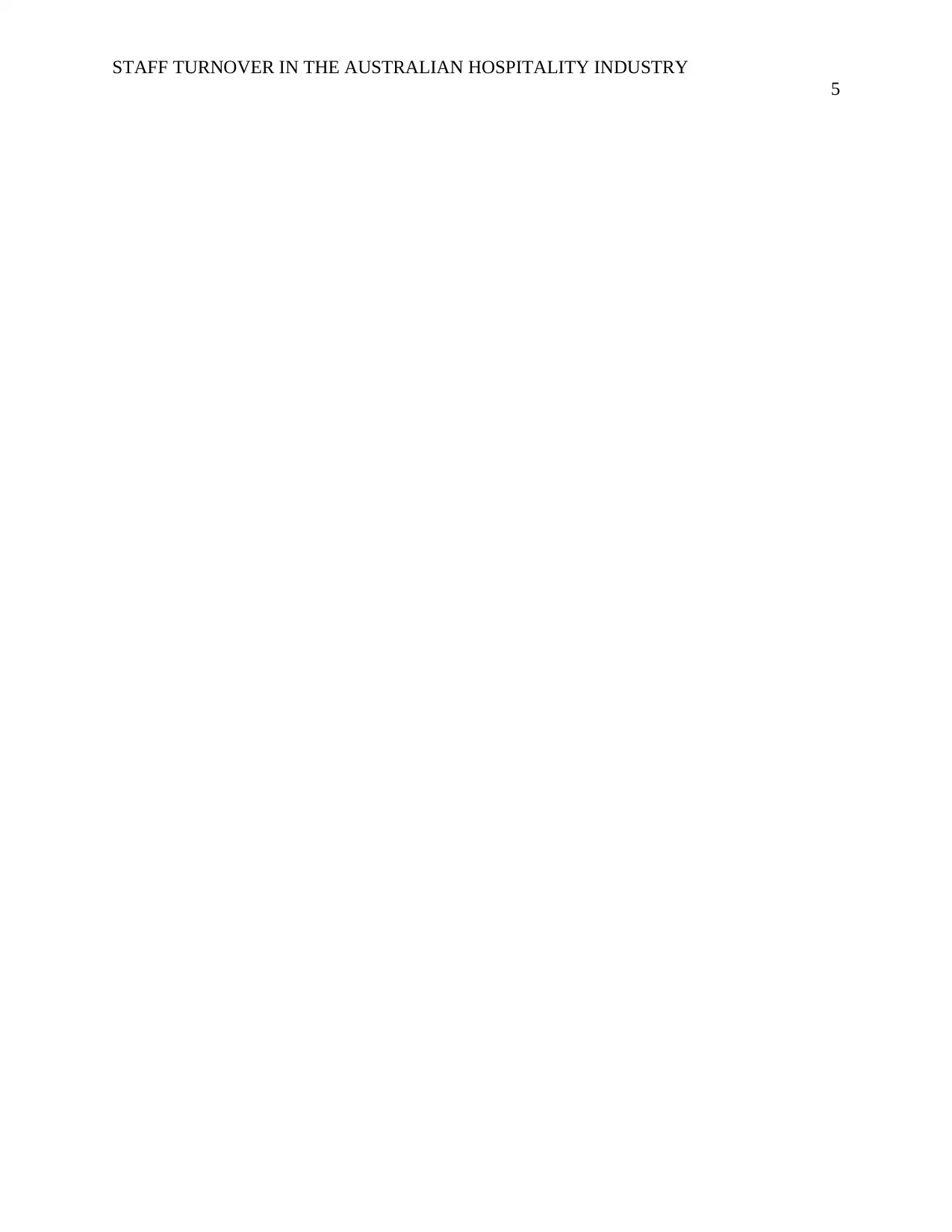
STAFF TURNOVER IN THE AUSTRALIAN HOSPITALITY INDUSTRY
5
5
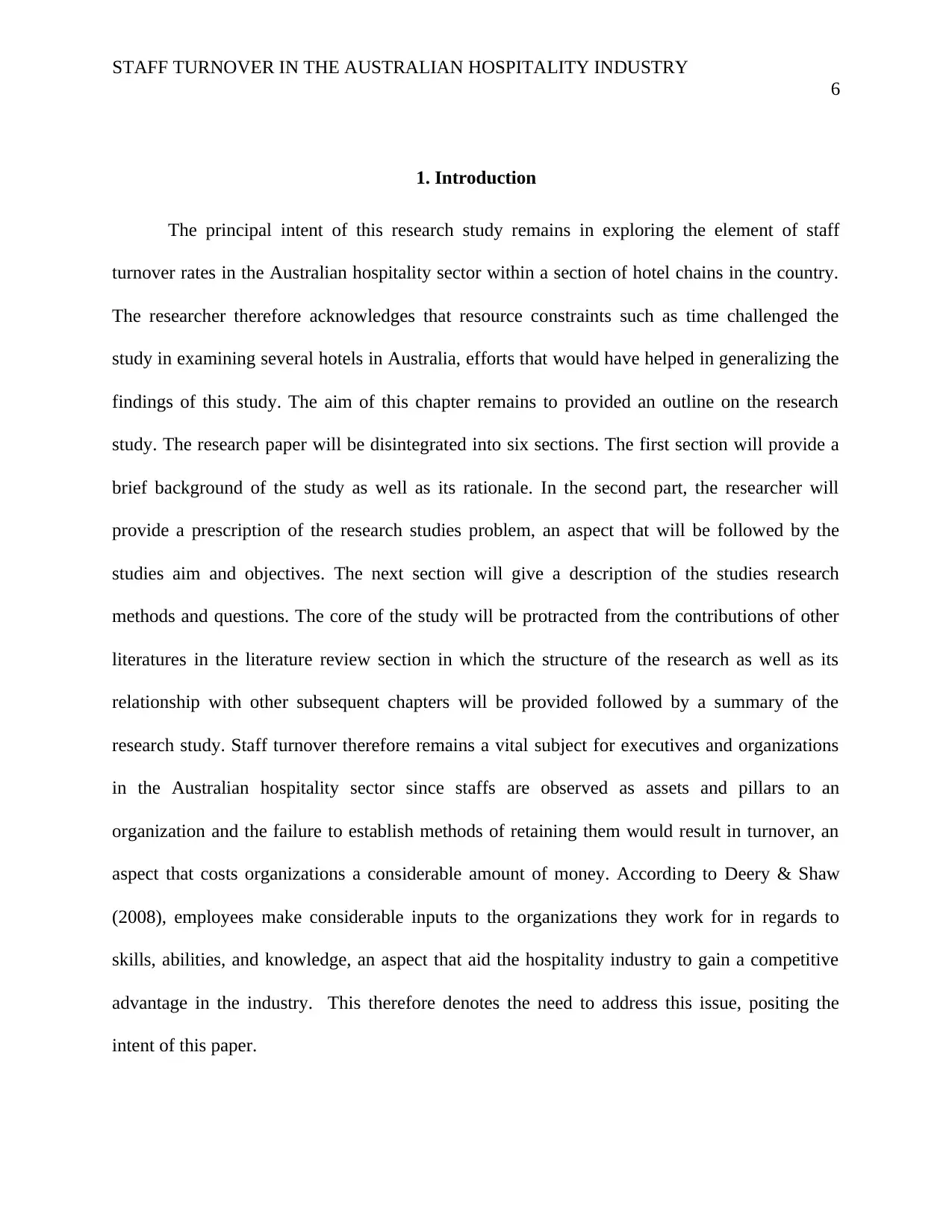
STAFF TURNOVER IN THE AUSTRALIAN HOSPITALITY INDUSTRY
6
1. Introduction
The principal intent of this research study remains in exploring the element of staff
turnover rates in the Australian hospitality sector within a section of hotel chains in the country.
The researcher therefore acknowledges that resource constraints such as time challenged the
study in examining several hotels in Australia, efforts that would have helped in generalizing the
findings of this study. The aim of this chapter remains to provided an outline on the research
study. The research paper will be disintegrated into six sections. The first section will provide a
brief background of the study as well as its rationale. In the second part, the researcher will
provide a prescription of the research studies problem, an aspect that will be followed by the
studies aim and objectives. The next section will give a description of the studies research
methods and questions. The core of the study will be protracted from the contributions of other
literatures in the literature review section in which the structure of the research as well as its
relationship with other subsequent chapters will be provided followed by a summary of the
research study. Staff turnover therefore remains a vital subject for executives and organizations
in the Australian hospitality sector since staffs are observed as assets and pillars to an
organization and the failure to establish methods of retaining them would result in turnover, an
aspect that costs organizations a considerable amount of money. According to Deery & Shaw
(2008), employees make considerable inputs to the organizations they work for in regards to
skills, abilities, and knowledge, an aspect that aid the hospitality industry to gain a competitive
advantage in the industry. This therefore denotes the need to address this issue, positing the
intent of this paper.
6
1. Introduction
The principal intent of this research study remains in exploring the element of staff
turnover rates in the Australian hospitality sector within a section of hotel chains in the country.
The researcher therefore acknowledges that resource constraints such as time challenged the
study in examining several hotels in Australia, efforts that would have helped in generalizing the
findings of this study. The aim of this chapter remains to provided an outline on the research
study. The research paper will be disintegrated into six sections. The first section will provide a
brief background of the study as well as its rationale. In the second part, the researcher will
provide a prescription of the research studies problem, an aspect that will be followed by the
studies aim and objectives. The next section will give a description of the studies research
methods and questions. The core of the study will be protracted from the contributions of other
literatures in the literature review section in which the structure of the research as well as its
relationship with other subsequent chapters will be provided followed by a summary of the
research study. Staff turnover therefore remains a vital subject for executives and organizations
in the Australian hospitality sector since staffs are observed as assets and pillars to an
organization and the failure to establish methods of retaining them would result in turnover, an
aspect that costs organizations a considerable amount of money. According to Deery & Shaw
(2008), employees make considerable inputs to the organizations they work for in regards to
skills, abilities, and knowledge, an aspect that aid the hospitality industry to gain a competitive
advantage in the industry. This therefore denotes the need to address this issue, positing the
intent of this paper.
⊘ This is a preview!⊘
Do you want full access?
Subscribe today to unlock all pages.

Trusted by 1+ million students worldwide
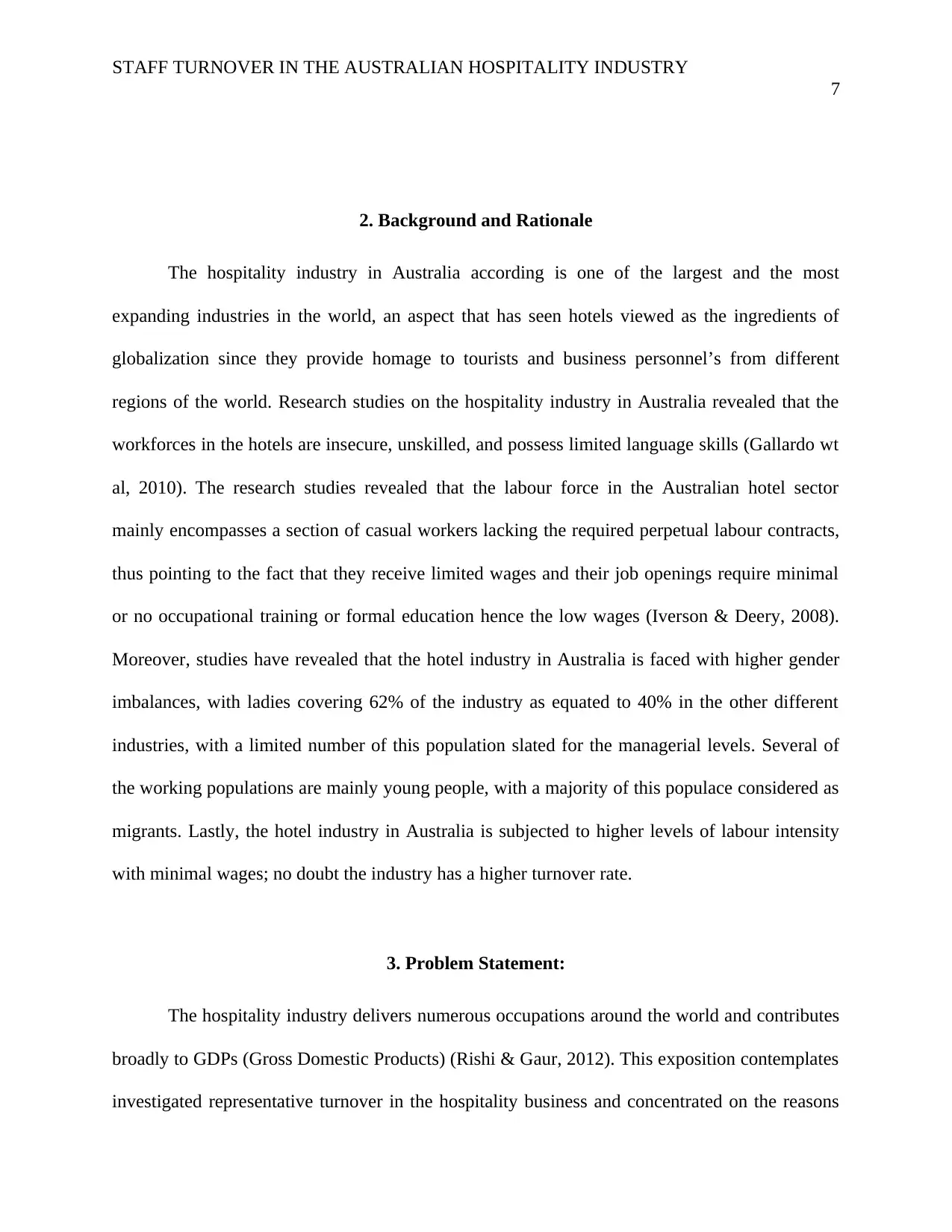
STAFF TURNOVER IN THE AUSTRALIAN HOSPITALITY INDUSTRY
7
2. Background and Rationale
The hospitality industry in Australia according is one of the largest and the most
expanding industries in the world, an aspect that has seen hotels viewed as the ingredients of
globalization since they provide homage to tourists and business personnel’s from different
regions of the world. Research studies on the hospitality industry in Australia revealed that the
workforces in the hotels are insecure, unskilled, and possess limited language skills (Gallardo wt
al, 2010). The research studies revealed that the labour force in the Australian hotel sector
mainly encompasses a section of casual workers lacking the required perpetual labour contracts,
thus pointing to the fact that they receive limited wages and their job openings require minimal
or no occupational training or formal education hence the low wages (Iverson & Deery, 2008).
Moreover, studies have revealed that the hotel industry in Australia is faced with higher gender
imbalances, with ladies covering 62% of the industry as equated to 40% in the other different
industries, with a limited number of this population slated for the managerial levels. Several of
the working populations are mainly young people, with a majority of this populace considered as
migrants. Lastly, the hotel industry in Australia is subjected to higher levels of labour intensity
with minimal wages; no doubt the industry has a higher turnover rate.
3. Problem Statement:
The hospitality industry delivers numerous occupations around the world and contributes
broadly to GDPs (Gross Domestic Products) (Rishi & Gaur, 2012). This exposition contemplates
investigated representative turnover in the hospitality business and concentrated on the reasons
7
2. Background and Rationale
The hospitality industry in Australia according is one of the largest and the most
expanding industries in the world, an aspect that has seen hotels viewed as the ingredients of
globalization since they provide homage to tourists and business personnel’s from different
regions of the world. Research studies on the hospitality industry in Australia revealed that the
workforces in the hotels are insecure, unskilled, and possess limited language skills (Gallardo wt
al, 2010). The research studies revealed that the labour force in the Australian hotel sector
mainly encompasses a section of casual workers lacking the required perpetual labour contracts,
thus pointing to the fact that they receive limited wages and their job openings require minimal
or no occupational training or formal education hence the low wages (Iverson & Deery, 2008).
Moreover, studies have revealed that the hotel industry in Australia is faced with higher gender
imbalances, with ladies covering 62% of the industry as equated to 40% in the other different
industries, with a limited number of this population slated for the managerial levels. Several of
the working populations are mainly young people, with a majority of this populace considered as
migrants. Lastly, the hotel industry in Australia is subjected to higher levels of labour intensity
with minimal wages; no doubt the industry has a higher turnover rate.
3. Problem Statement:
The hospitality industry delivers numerous occupations around the world and contributes
broadly to GDPs (Gross Domestic Products) (Rishi & Gaur, 2012). This exposition contemplates
investigated representative turnover in the hospitality business and concentrated on the reasons
Paraphrase This Document
Need a fresh take? Get an instant paraphrase of this document with our AI Paraphraser
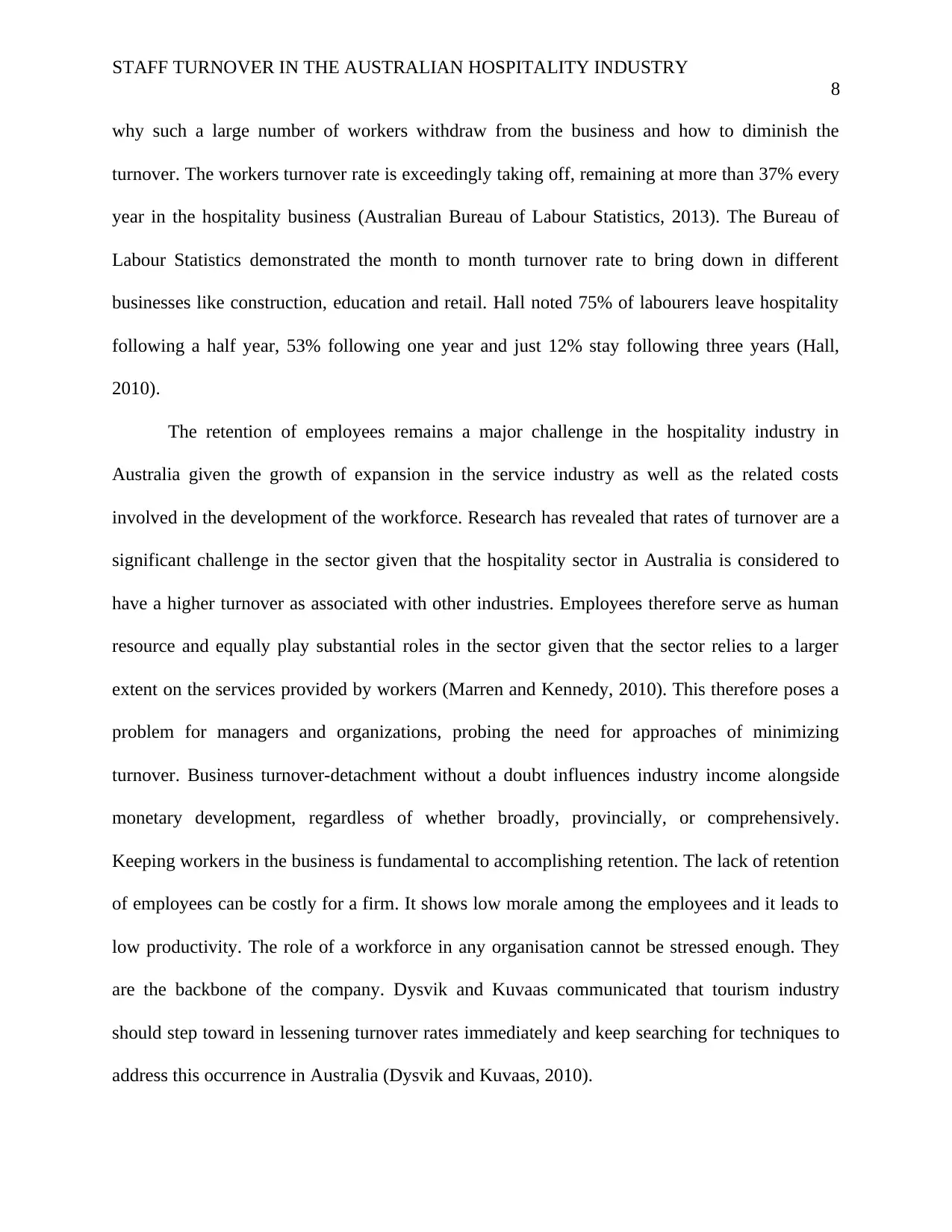
STAFF TURNOVER IN THE AUSTRALIAN HOSPITALITY INDUSTRY
8
why such a large number of workers withdraw from the business and how to diminish the
turnover. The workers turnover rate is exceedingly taking off, remaining at more than 37% every
year in the hospitality business (Australian Bureau of Labour Statistics, 2013). The Bureau of
Labour Statistics demonstrated the month to month turnover rate to bring down in different
businesses like construction, education and retail. Hall noted 75% of labourers leave hospitality
following a half year, 53% following one year and just 12% stay following three years (Hall,
2010).
The retention of employees remains a major challenge in the hospitality industry in
Australia given the growth of expansion in the service industry as well as the related costs
involved in the development of the workforce. Research has revealed that rates of turnover are a
significant challenge in the sector given that the hospitality sector in Australia is considered to
have a higher turnover as associated with other industries. Employees therefore serve as human
resource and equally play substantial roles in the sector given that the sector relies to a larger
extent on the services provided by workers (Marren and Kennedy, 2010). This therefore poses a
problem for managers and organizations, probing the need for approaches of minimizing
turnover. Business turnover-detachment without a doubt influences industry income alongside
monetary development, regardless of whether broadly, provincially, or comprehensively.
Keeping workers in the business is fundamental to accomplishing retention. The lack of retention
of employees can be costly for a firm. It shows low morale among the employees and it leads to
low productivity. The role of a workforce in any organisation cannot be stressed enough. They
are the backbone of the company. Dysvik and Kuvaas communicated that tourism industry
should step toward in lessening turnover rates immediately and keep searching for techniques to
address this occurrence in Australia (Dysvik and Kuvaas, 2010).
8
why such a large number of workers withdraw from the business and how to diminish the
turnover. The workers turnover rate is exceedingly taking off, remaining at more than 37% every
year in the hospitality business (Australian Bureau of Labour Statistics, 2013). The Bureau of
Labour Statistics demonstrated the month to month turnover rate to bring down in different
businesses like construction, education and retail. Hall noted 75% of labourers leave hospitality
following a half year, 53% following one year and just 12% stay following three years (Hall,
2010).
The retention of employees remains a major challenge in the hospitality industry in
Australia given the growth of expansion in the service industry as well as the related costs
involved in the development of the workforce. Research has revealed that rates of turnover are a
significant challenge in the sector given that the hospitality sector in Australia is considered to
have a higher turnover as associated with other industries. Employees therefore serve as human
resource and equally play substantial roles in the sector given that the sector relies to a larger
extent on the services provided by workers (Marren and Kennedy, 2010). This therefore poses a
problem for managers and organizations, probing the need for approaches of minimizing
turnover. Business turnover-detachment without a doubt influences industry income alongside
monetary development, regardless of whether broadly, provincially, or comprehensively.
Keeping workers in the business is fundamental to accomplishing retention. The lack of retention
of employees can be costly for a firm. It shows low morale among the employees and it leads to
low productivity. The role of a workforce in any organisation cannot be stressed enough. They
are the backbone of the company. Dysvik and Kuvaas communicated that tourism industry
should step toward in lessening turnover rates immediately and keep searching for techniques to
address this occurrence in Australia (Dysvik and Kuvaas, 2010).
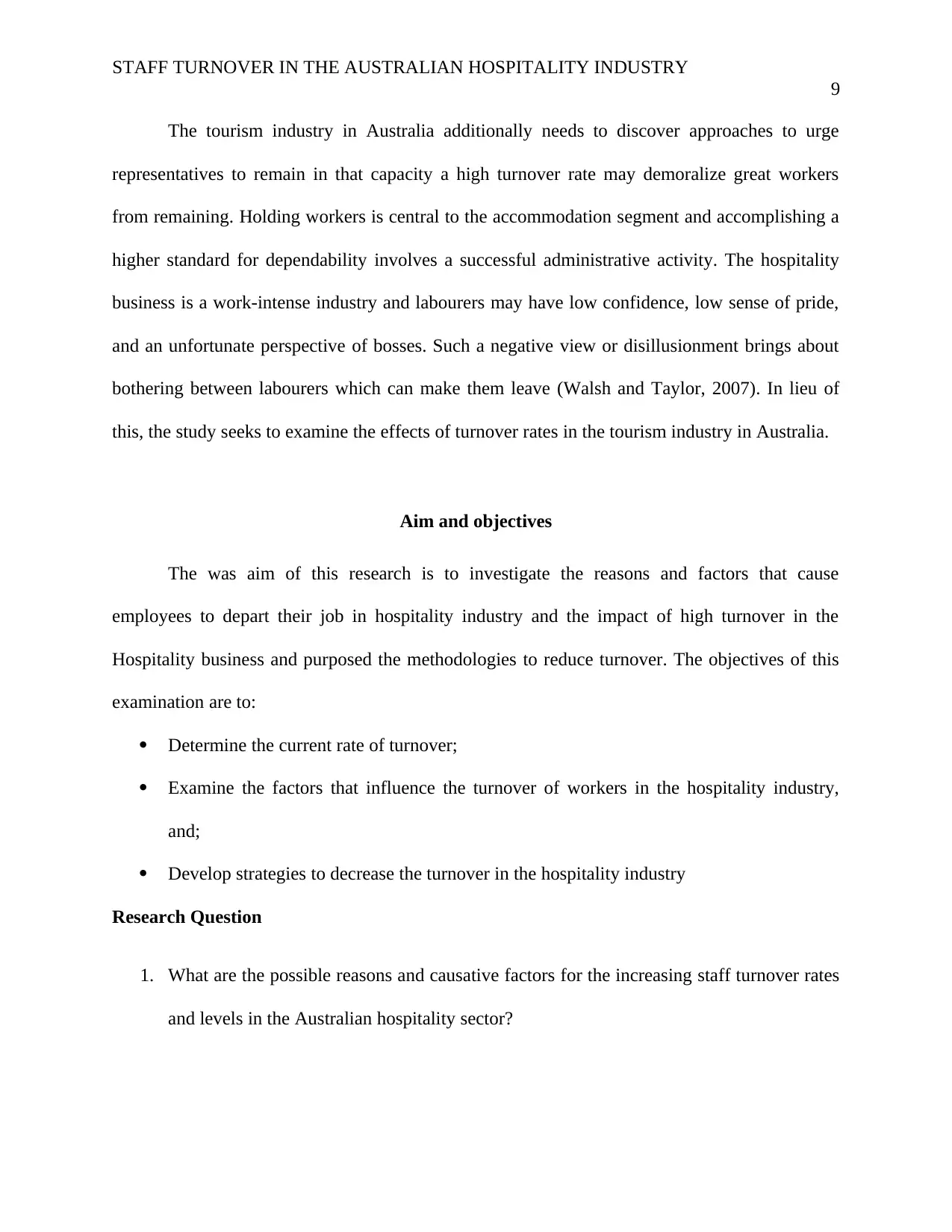
STAFF TURNOVER IN THE AUSTRALIAN HOSPITALITY INDUSTRY
9
The tourism industry in Australia additionally needs to discover approaches to urge
representatives to remain in that capacity a high turnover rate may demoralize great workers
from remaining. Holding workers is central to the accommodation segment and accomplishing a
higher standard for dependability involves a successful administrative activity. The hospitality
business is a work-intense industry and labourers may have low confidence, low sense of pride,
and an unfortunate perspective of bosses. Such a negative view or disillusionment brings about
bothering between labourers which can make them leave (Walsh and Taylor, 2007). In lieu of
this, the study seeks to examine the effects of turnover rates in the tourism industry in Australia.
Aim and objectives
The was aim of this research is to investigate the reasons and factors that cause
employees to depart their job in hospitality industry and the impact of high turnover in the
Hospitality business and purposed the methodologies to reduce turnover. The objectives of this
examination are to:
Determine the current rate of turnover;
Examine the factors that influence the turnover of workers in the hospitality industry,
and;
Develop strategies to decrease the turnover in the hospitality industry
Research Question
1. What are the possible reasons and causative factors for the increasing staff turnover rates
and levels in the Australian hospitality sector?
9
The tourism industry in Australia additionally needs to discover approaches to urge
representatives to remain in that capacity a high turnover rate may demoralize great workers
from remaining. Holding workers is central to the accommodation segment and accomplishing a
higher standard for dependability involves a successful administrative activity. The hospitality
business is a work-intense industry and labourers may have low confidence, low sense of pride,
and an unfortunate perspective of bosses. Such a negative view or disillusionment brings about
bothering between labourers which can make them leave (Walsh and Taylor, 2007). In lieu of
this, the study seeks to examine the effects of turnover rates in the tourism industry in Australia.
Aim and objectives
The was aim of this research is to investigate the reasons and factors that cause
employees to depart their job in hospitality industry and the impact of high turnover in the
Hospitality business and purposed the methodologies to reduce turnover. The objectives of this
examination are to:
Determine the current rate of turnover;
Examine the factors that influence the turnover of workers in the hospitality industry,
and;
Develop strategies to decrease the turnover in the hospitality industry
Research Question
1. What are the possible reasons and causative factors for the increasing staff turnover rates
and levels in the Australian hospitality sector?
⊘ This is a preview!⊘
Do you want full access?
Subscribe today to unlock all pages.

Trusted by 1+ million students worldwide
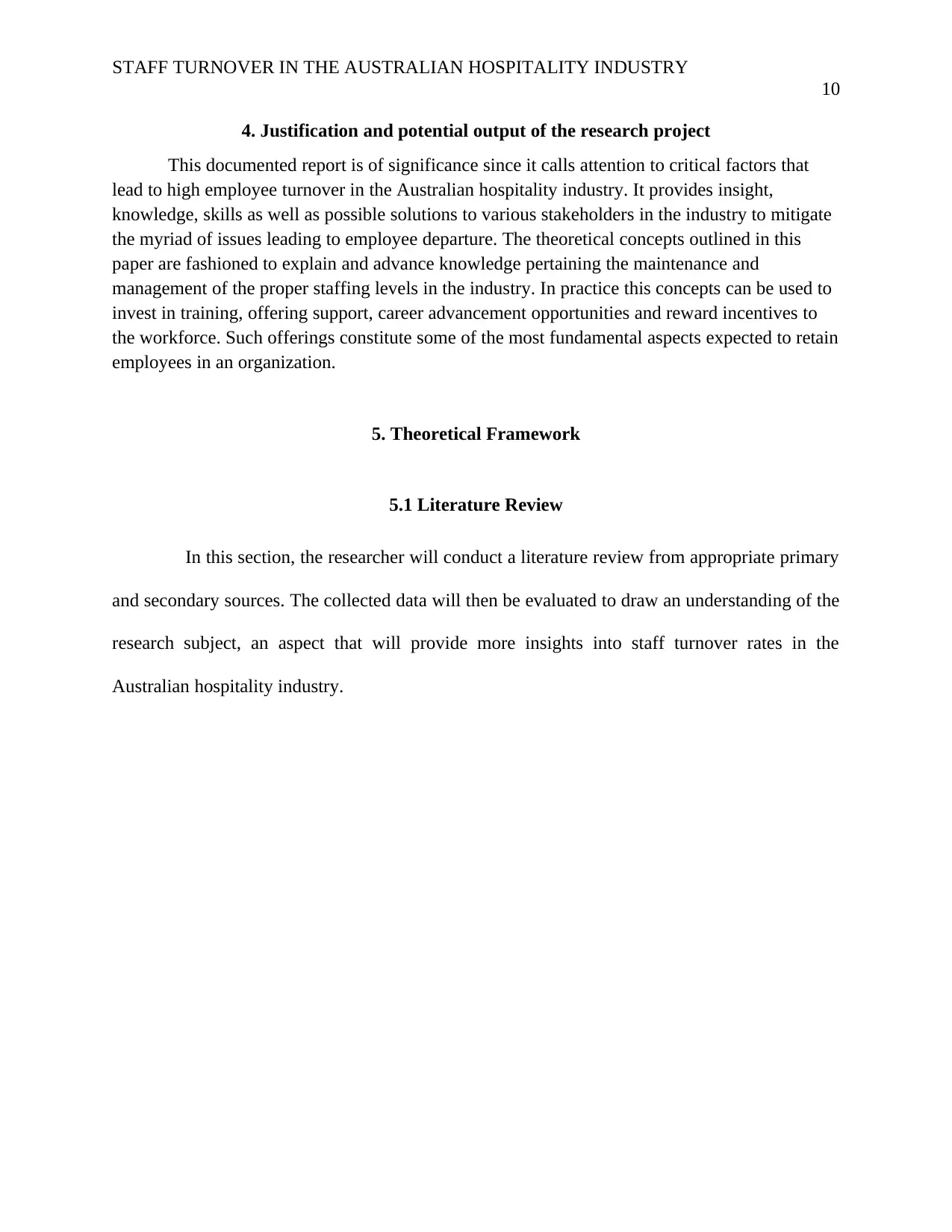
STAFF TURNOVER IN THE AUSTRALIAN HOSPITALITY INDUSTRY
10
4. Justification and potential output of the research project
This documented report is of significance since it calls attention to critical factors that
lead to high employee turnover in the Australian hospitality industry. It provides insight,
knowledge, skills as well as possible solutions to various stakeholders in the industry to mitigate
the myriad of issues leading to employee departure. The theoretical concepts outlined in this
paper are fashioned to explain and advance knowledge pertaining the maintenance and
management of the proper staffing levels in the industry. In practice this concepts can be used to
invest in training, offering support, career advancement opportunities and reward incentives to
the workforce. Such offerings constitute some of the most fundamental aspects expected to retain
employees in an organization.
5. Theoretical Framework
5.1 Literature Review
In this section, the researcher will conduct a literature review from appropriate primary
and secondary sources. The collected data will then be evaluated to draw an understanding of the
research subject, an aspect that will provide more insights into staff turnover rates in the
Australian hospitality industry.
10
4. Justification and potential output of the research project
This documented report is of significance since it calls attention to critical factors that
lead to high employee turnover in the Australian hospitality industry. It provides insight,
knowledge, skills as well as possible solutions to various stakeholders in the industry to mitigate
the myriad of issues leading to employee departure. The theoretical concepts outlined in this
paper are fashioned to explain and advance knowledge pertaining the maintenance and
management of the proper staffing levels in the industry. In practice this concepts can be used to
invest in training, offering support, career advancement opportunities and reward incentives to
the workforce. Such offerings constitute some of the most fundamental aspects expected to retain
employees in an organization.
5. Theoretical Framework
5.1 Literature Review
In this section, the researcher will conduct a literature review from appropriate primary
and secondary sources. The collected data will then be evaluated to draw an understanding of the
research subject, an aspect that will provide more insights into staff turnover rates in the
Australian hospitality industry.
Paraphrase This Document
Need a fresh take? Get an instant paraphrase of this document with our AI Paraphraser
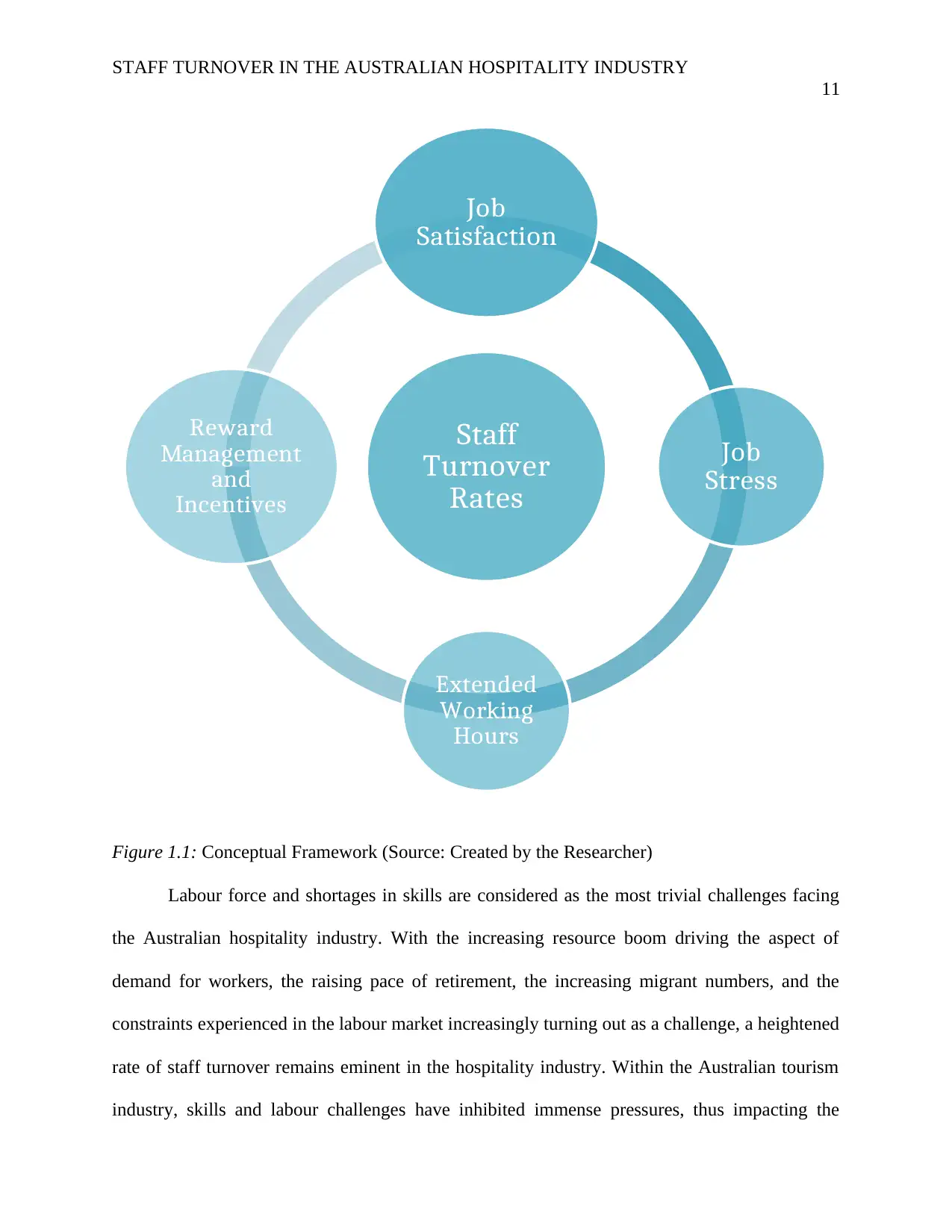
STAFF TURNOVER IN THE AUSTRALIAN HOSPITALITY INDUSTRY
11
Figure 1.1: Conceptual Framework (Source: Created by the Researcher)
Labour force and shortages in skills are considered as the most trivial challenges facing
the Australian hospitality industry. With the increasing resource boom driving the aspect of
demand for workers, the raising pace of retirement, the increasing migrant numbers, and the
constraints experienced in the labour market increasingly turning out as a challenge, a heightened
rate of staff turnover remains eminent in the hospitality industry. Within the Australian tourism
industry, skills and labour challenges have inhibited immense pressures, thus impacting the
Staff
Turnover
Rates
Job
Satisfaction
Job
Stress
Extended
Working
Hours
Reward
Management
and
Incentives
11
Figure 1.1: Conceptual Framework (Source: Created by the Researcher)
Labour force and shortages in skills are considered as the most trivial challenges facing
the Australian hospitality industry. With the increasing resource boom driving the aspect of
demand for workers, the raising pace of retirement, the increasing migrant numbers, and the
constraints experienced in the labour market increasingly turning out as a challenge, a heightened
rate of staff turnover remains eminent in the hospitality industry. Within the Australian tourism
industry, skills and labour challenges have inhibited immense pressures, thus impacting the
Staff
Turnover
Rates
Job
Satisfaction
Job
Stress
Extended
Working
Hours
Reward
Management
and
Incentives
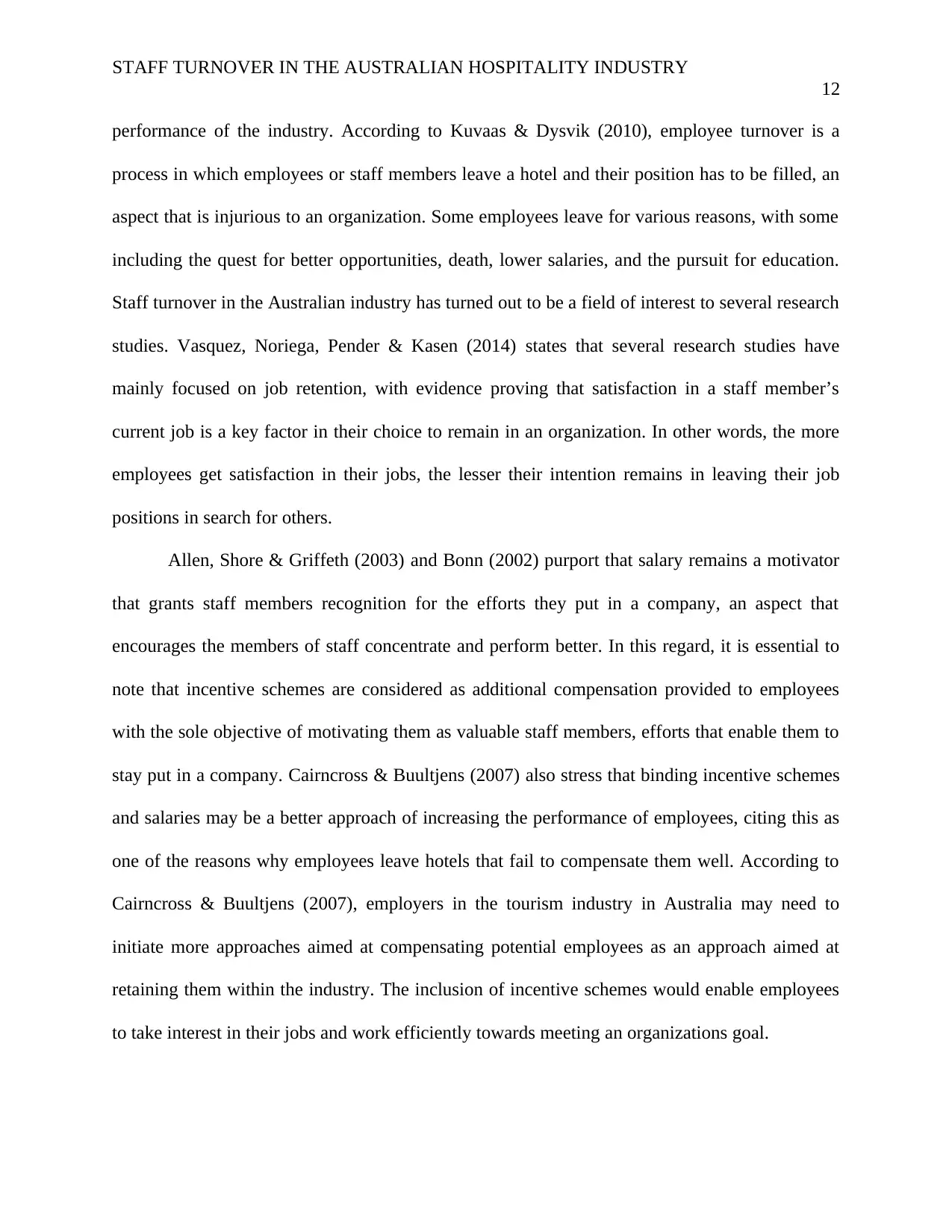
STAFF TURNOVER IN THE AUSTRALIAN HOSPITALITY INDUSTRY
12
performance of the industry. According to Kuvaas & Dysvik (2010), employee turnover is a
process in which employees or staff members leave a hotel and their position has to be filled, an
aspect that is injurious to an organization. Some employees leave for various reasons, with some
including the quest for better opportunities, death, lower salaries, and the pursuit for education.
Staff turnover in the Australian industry has turned out to be a field of interest to several research
studies. Vasquez, Noriega, Pender & Kasen (2014) states that several research studies have
mainly focused on job retention, with evidence proving that satisfaction in a staff member’s
current job is a key factor in their choice to remain in an organization. In other words, the more
employees get satisfaction in their jobs, the lesser their intention remains in leaving their job
positions in search for others.
Allen, Shore & Griffeth (2003) and Bonn (2002) purport that salary remains a motivator
that grants staff members recognition for the efforts they put in a company, an aspect that
encourages the members of staff concentrate and perform better. In this regard, it is essential to
note that incentive schemes are considered as additional compensation provided to employees
with the sole objective of motivating them as valuable staff members, efforts that enable them to
stay put in a company. Cairncross & Buultjens (2007) also stress that binding incentive schemes
and salaries may be a better approach of increasing the performance of employees, citing this as
one of the reasons why employees leave hotels that fail to compensate them well. According to
Cairncross & Buultjens (2007), employers in the tourism industry in Australia may need to
initiate more approaches aimed at compensating potential employees as an approach aimed at
retaining them within the industry. The inclusion of incentive schemes would enable employees
to take interest in their jobs and work efficiently towards meeting an organizations goal.
12
performance of the industry. According to Kuvaas & Dysvik (2010), employee turnover is a
process in which employees or staff members leave a hotel and their position has to be filled, an
aspect that is injurious to an organization. Some employees leave for various reasons, with some
including the quest for better opportunities, death, lower salaries, and the pursuit for education.
Staff turnover in the Australian industry has turned out to be a field of interest to several research
studies. Vasquez, Noriega, Pender & Kasen (2014) states that several research studies have
mainly focused on job retention, with evidence proving that satisfaction in a staff member’s
current job is a key factor in their choice to remain in an organization. In other words, the more
employees get satisfaction in their jobs, the lesser their intention remains in leaving their job
positions in search for others.
Allen, Shore & Griffeth (2003) and Bonn (2002) purport that salary remains a motivator
that grants staff members recognition for the efforts they put in a company, an aspect that
encourages the members of staff concentrate and perform better. In this regard, it is essential to
note that incentive schemes are considered as additional compensation provided to employees
with the sole objective of motivating them as valuable staff members, efforts that enable them to
stay put in a company. Cairncross & Buultjens (2007) also stress that binding incentive schemes
and salaries may be a better approach of increasing the performance of employees, citing this as
one of the reasons why employees leave hotels that fail to compensate them well. According to
Cairncross & Buultjens (2007), employers in the tourism industry in Australia may need to
initiate more approaches aimed at compensating potential employees as an approach aimed at
retaining them within the industry. The inclusion of incentive schemes would enable employees
to take interest in their jobs and work efficiently towards meeting an organizations goal.
⊘ This is a preview!⊘
Do you want full access?
Subscribe today to unlock all pages.

Trusted by 1+ million students worldwide
1 out of 23
Related Documents
Your All-in-One AI-Powered Toolkit for Academic Success.
+13062052269
info@desklib.com
Available 24*7 on WhatsApp / Email
![[object Object]](/_next/static/media/star-bottom.7253800d.svg)
Unlock your academic potential
Copyright © 2020–2025 A2Z Services. All Rights Reserved. Developed and managed by ZUCOL.





